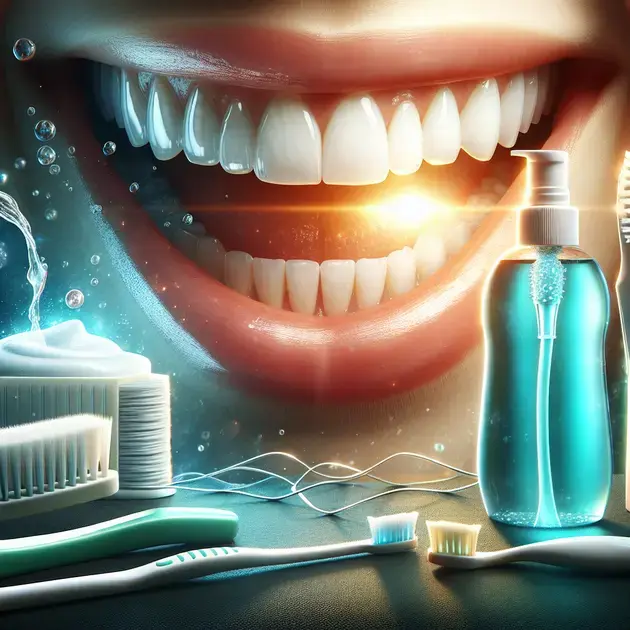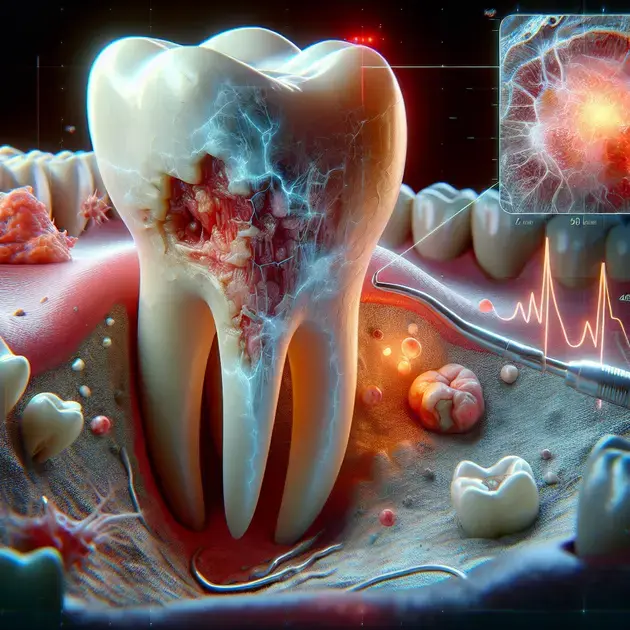Are you experiencing pain or sensitivity on the decay side of your tooth? If so, you may be wondering about the causes, symptoms, and treatment options available. Tooth decay is a common dental issue that can lead to various oral health problems if left untreated.
Understanding the decay side of a tooth can help you take the necessary steps to prevent further damage and restore your oral health. In this article, we will explore the causes, symptoms, and treatment options for decay on the side of a tooth.

Causes of Decay Side of Tooth
Tooth decay on the side of a tooth can be caused by various factors. One common cause is poor oral hygiene, which can lead to a buildup of plaque and bacteria on the tooth surface. This can eventually erode the enamel on the side of the tooth, leading to decay. Another common cause is consuming sugary and acidic foods and beverages, which can create an acidic environment in the mouth that contributes to decay.
Additionally, side decay can occur as a result of dental erosion, which is the gradual loss of tooth structure due to acid attacks. This can be caused by factors such as acid reflux, frequent consumption of citrus fruits, or exposure to acidic substances. Other potential causes of decay on the side of a tooth include dry mouth, smoking, and certain medical conditions.
If you notice any signs of decay on the side of your tooth, such as sensitivity, discoloration, or visible pits or holes, it’s important to see a dentist for a proper evaluation. Ignoring decay can lead to further damage and potential tooth loss.
One effective way to prevent decay on the side of a tooth is to maintain good oral hygiene practices, including brushing twice a day, flossing regularly, and visiting the dentist for check-ups and cleanings. Avoiding sugary and acidic foods and drinks can also help reduce the risk of decay.
For more information on the causes of decay on the side of a tooth and how to prevent it, you can visit reputable dental websites such as the American Dental Association (ADA) or the Colgate oral health center.
Symptoms to Look Out For
Recognizing the symptoms of decay on the side of a tooth is crucial for early intervention and treatment. Common symptoms to look out for include tooth sensitivity to hot, cold, or sweet foods, as well as pain or discomfort when biting or chewing. Discoloration or visible holes on the side of the tooth may also indicate decay.
Other symptoms of decay may include bad breath, a foul taste in the mouth, or swelling around the affected tooth. In some cases, you may experience a sharp pain when consuming certain foods or beverages. If you notice any of these symptoms, it’s important to seek dental care promptly.
Effective treatment options for decay on the side of a tooth depend on the extent of the damage. In early stages, the decay can be treated with a dental filling to restore the tooth structure. However, if the decay has progressed to a more advanced stage, a dental crown or root canal therapy may be necessary.
During a dental examination, your dentist will evaluate the extent of the decay and recommend the most appropriate treatment. It’s important to follow your dentist’s recommendations and maintain good oral hygiene habits to prevent further decay.
For detailed information on symptoms of decay on the side of a tooth and treatment options, you can refer to reliable sources such as WebMD Dental Health or the Mayo Clinic website.
Effective Treatment Options
When it comes to treating decay on the side of a tooth, there are several effective options available. The choice of treatment will depend on the severity of the decay and the individual’s oral health. One common treatment option is the placement of a dental filling, which involves removing the decayed portion of the tooth and filling the space with a tooth-colored material.
If the decay is more extensive, a dental crown may be recommended to restore the tooth’s structure and function. A dental crown is a custom-made cap that covers the entire tooth and provides protection and support. In cases where the decay has reached the tooth’s pulp, root canal therapy may be necessary to remove the infected tissue and seal the tooth.
In some situations, if the decay has caused significant damage to the tooth structure, extraction may be the only viable treatment option. However, tooth extraction is usually considered a last resort, and dentists will explore other options to save the tooth whenever possible.
After receiving treatment for decay on the side of a tooth, it’s essential to follow your dentist’s instructions for post-treatment care. This may include practicing good oral hygiene, avoiding hard or sticky foods, and attending follow-up appointments for monitoring and maintenance.
For comprehensive information on effective treatment options for tooth decay, you can visit authoritative dental resources such as the National Institutes of Health (NIH) Dental Care page or consult with a qualified dentist in your area.

Potential Complications to be Aware Of
When it comes to oral health, there are several potential complications that individuals should be aware of to maintain a healthy smile. One of the main complications is gum disease, which can lead to red, swollen, and bleeding gums if left untreated. Additionally, untreated cavities can result in tooth decay and potentially the loss of teeth. Poor oral hygiene can also contribute to bad breath, also known as halitosis, which can be embarrassing and impact your self-confidence.
Another complication to be aware of is oral cancer, which can affect the lips, tongue, cheeks, and throat. Early detection is key to successfully treating oral cancer, making regular dental check-ups crucial for your overall health. Moreover, untreated oral health issues can lead to systemic health problems, such as heart disease, stroke, and diabetes.
To prevent these potential complications, it is essential to maintain good oral hygiene habits, including brushing your teeth twice a day, flossing daily, and visiting your dentist regularly for check-ups and cleanings. By taking proactive steps to care for your oral health, you can reduce the risk of developing these complications and enjoy a healthy smile for years to come.
Remember, prevention is always better than treatment when it comes to oral health. By staying informed about the potential complications and prioritizing your oral hygiene, you can take control of your well-being and maintain a bright and healthy smile.
Preventive Measures for Oral Health
There are several preventive measures that individuals can take to promote good oral health and prevent dental issues. One of the most important steps is to brush your teeth at least twice a day with fluoride toothpaste to remove plaque and bacteria that can cause cavities and gum disease. Additionally, flossing daily helps remove food particles and plaque from between teeth where your toothbrush may not reach.
Regular dental check-ups are also essential for preventive care, as your dentist can detect early signs of oral health issues and provide treatment before they progress. Dental cleanings help remove built-up plaque and tartar, reducing the risk of cavities and gum disease. Furthermore, a balanced diet rich in fruits, vegetables, and calcium is beneficial for your oral health and overall well-being.
Avoiding tobacco products and limiting sugary snacks and drinks can also help prevent tooth decay and gum disease. Tobacco use is a major risk factor for oral cancer and gum disease, so quitting smoking and avoiding smokeless tobacco can significantly improve your oral health. By following these preventive measures and maintaining good oral hygiene habits, you can protect your smile and enjoy a lifetime of healthy teeth and gums.
Remember, prevention is key when it comes to oral health. By incorporating these preventive measures into your daily routine, you can reduce the risk of developing dental issues and ensure your smile stays bright and healthy for years to come.
Impact of Neglecting Tooth Decay
Neglecting tooth decay can have serious consequences for your oral health and overall well-being. When left untreated, cavities can progress and lead to infections, toothaches, and even tooth loss. The bacteria that cause tooth decay can also spread to other parts of the mouth, increasing the risk of gum disease and oral infections.
Moreover, neglecting tooth decay can affect your ability to eat and speak properly, impacting your quality of life. Tooth pain and sensitivity from cavities can make it difficult to enjoy your favorite foods and beverages, leading to nutritional deficiencies and overall health issues. Additionally, untreated cavities can cause bad breath and affect your self-confidence in social and professional settings.
Ignoring tooth decay can also result in the need for more extensive and costly dental treatments, such as root canals or tooth extractions. These procedures can be painful and time-consuming, highlighting the importance of addressing cavities early on to prevent complications and preserve your natural teeth.
To avoid the impact of neglecting tooth decay, it is crucial to practice good oral hygiene habits, including regular brushing, flossing, and dental check-ups. By taking proactive steps to address cavities early and prevent further decay, you can maintain a healthy smile and avoid the potential complications associated with untreated tooth decay.
Conclusion
In conclusion, maintaining good oral health is crucial to prevent potential complications such as gum disease, cavities, bad breath, oral cancer, and systemic health problems. By embracing preventive measures like regular brushing, flossing, and dental check-ups, individuals can protect their smiles and overall well-being.
Remember, prevention is key.
By incorporating these habits into your daily routine, you can significantly reduce the risk of developing oral health issues and ensure that your smile remains bright and healthy for years to come. Addressing tooth decay early, avoiding neglect, and practicing good oral hygiene are essential steps towards a lifetime of strong teeth and gums.